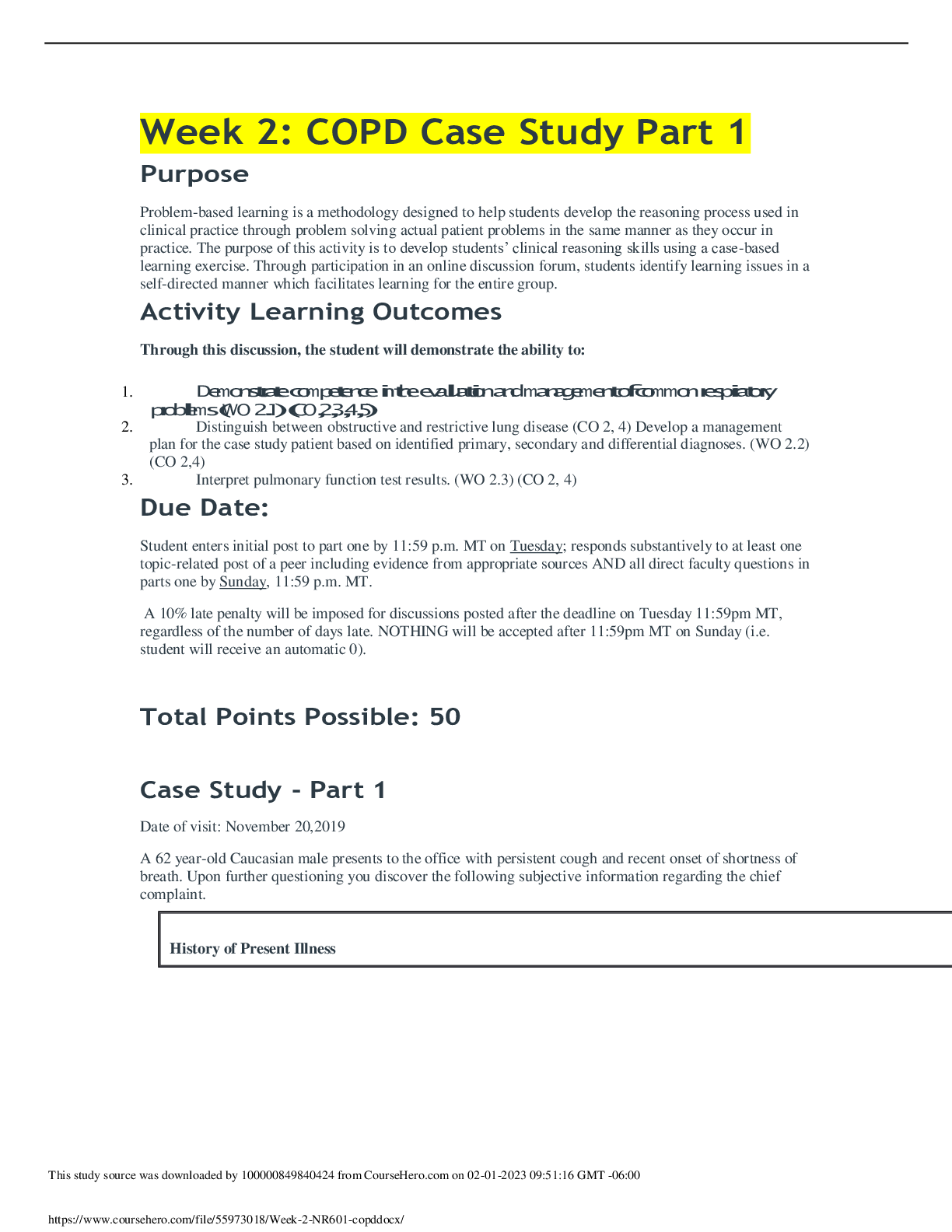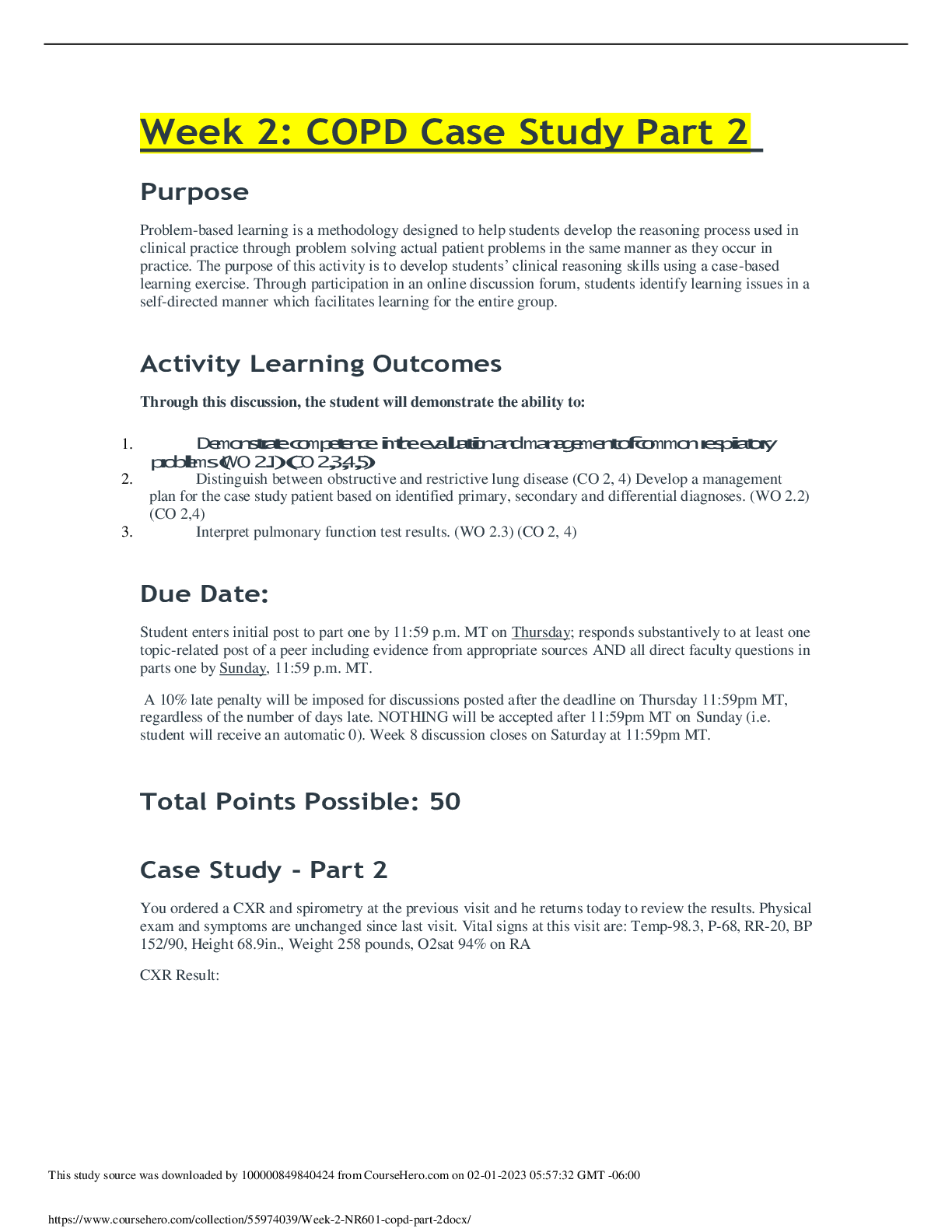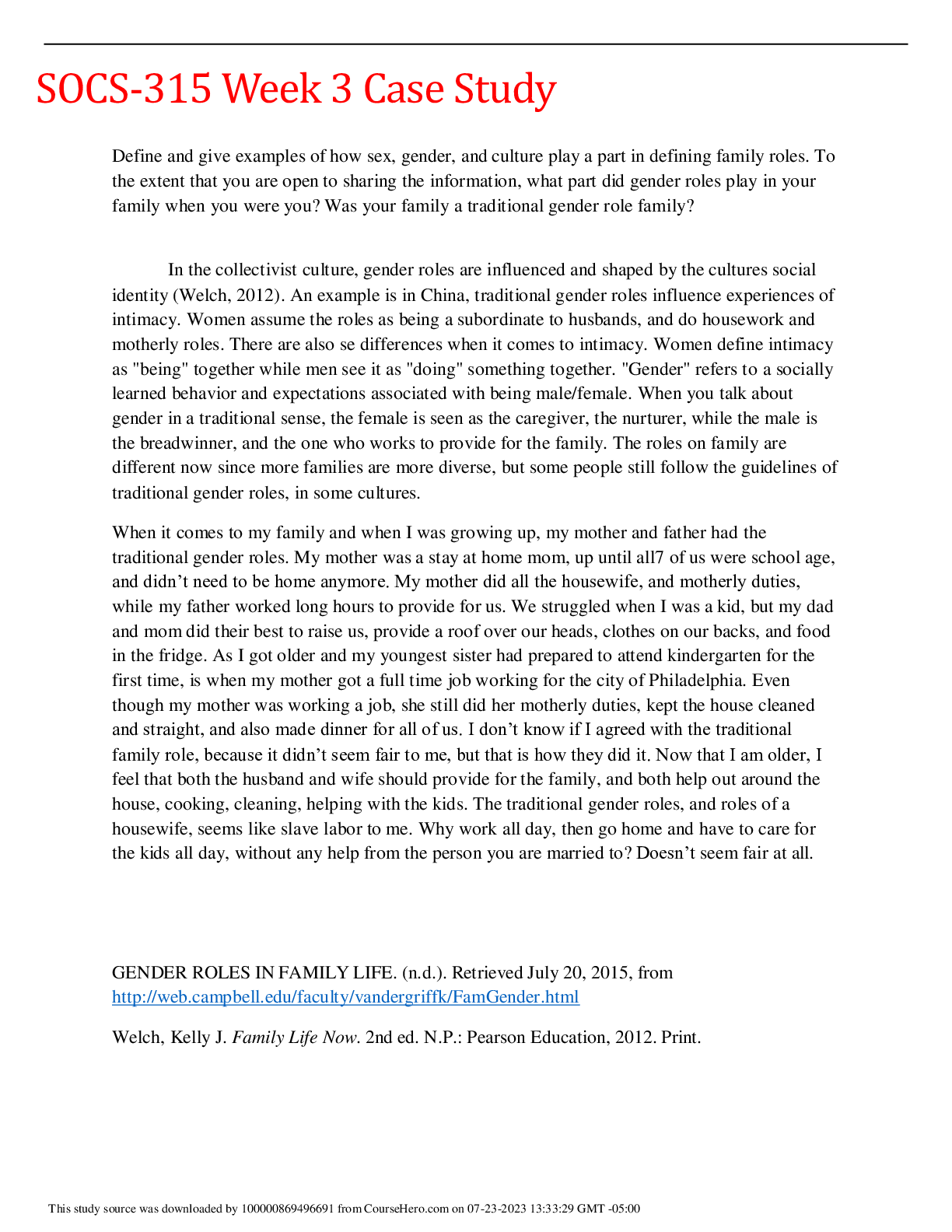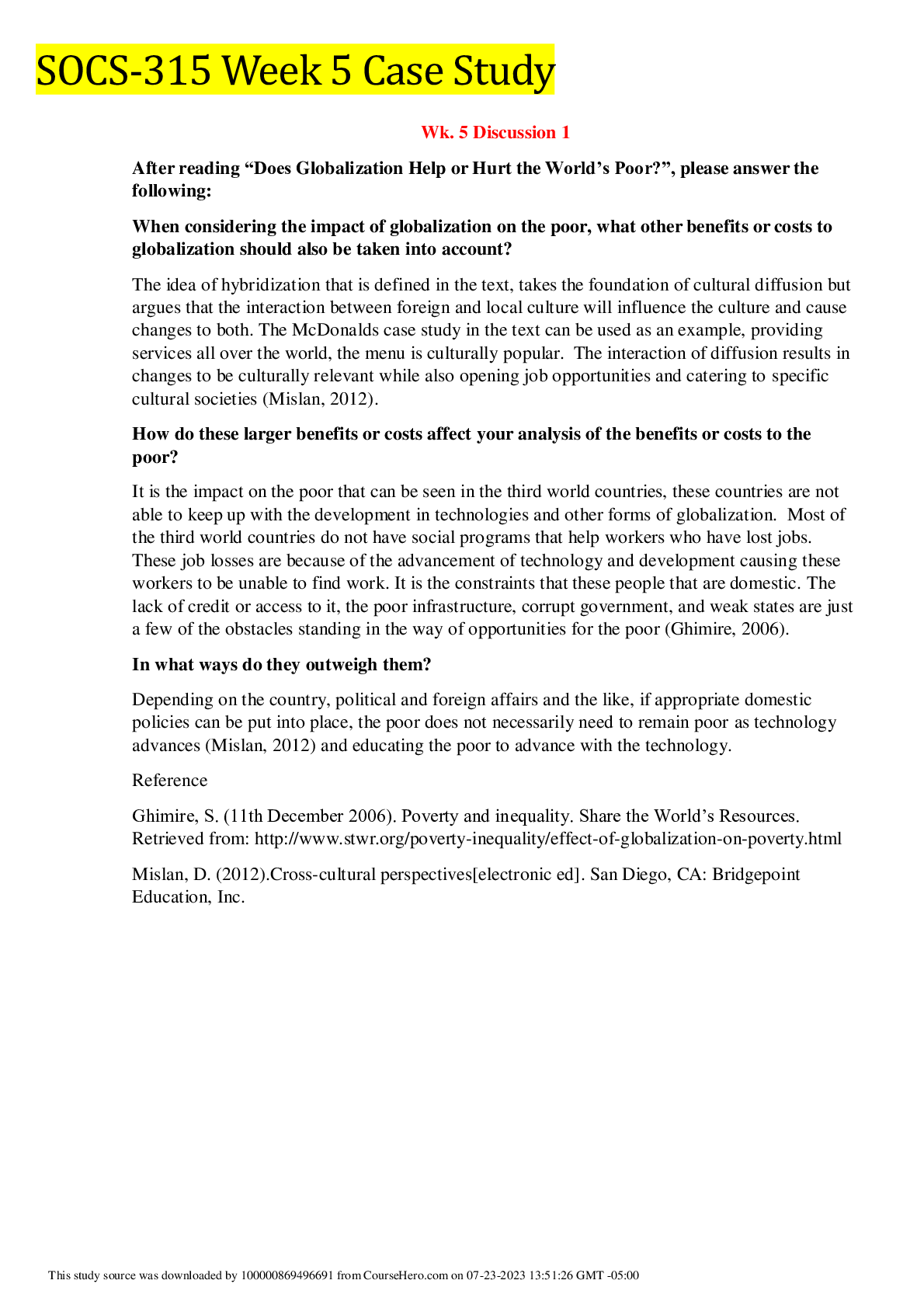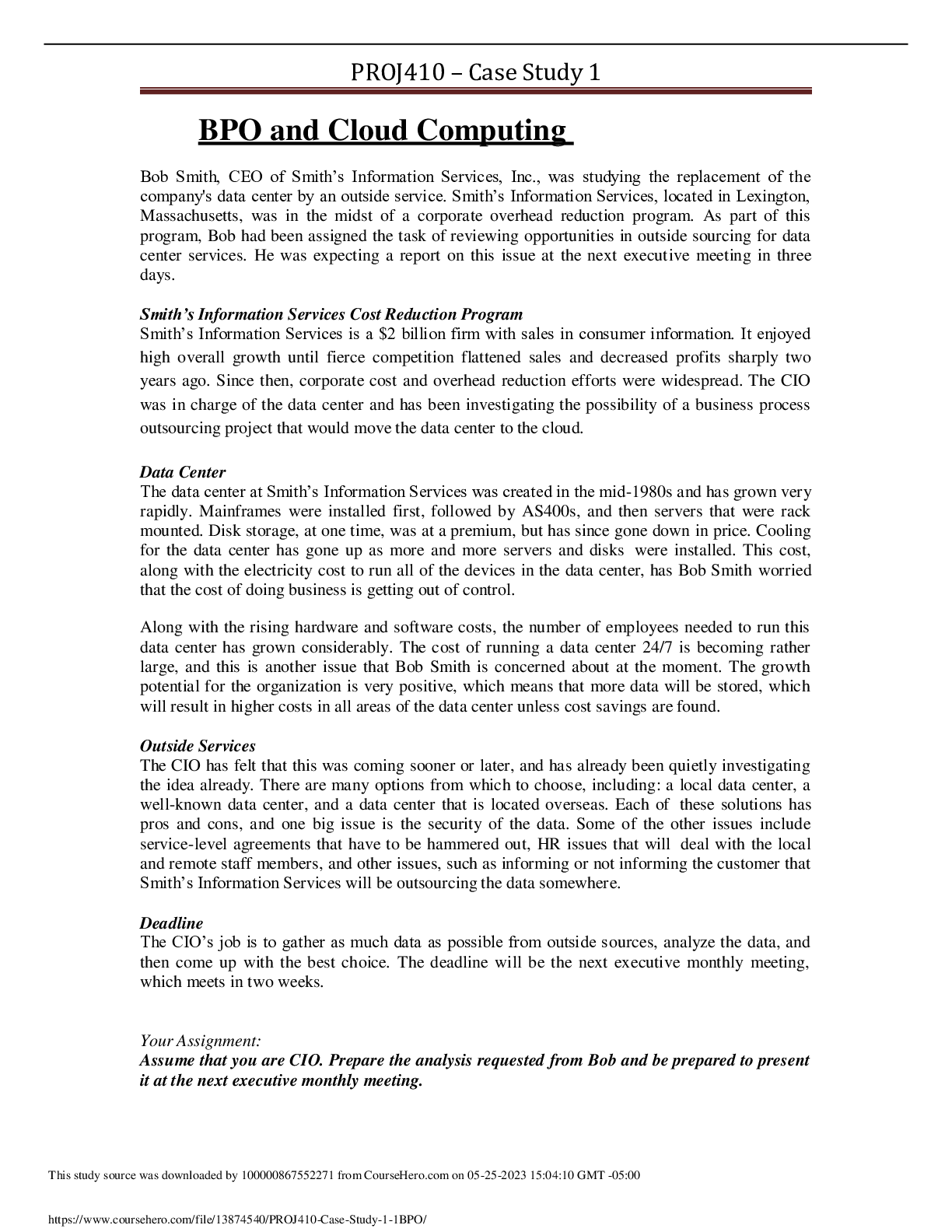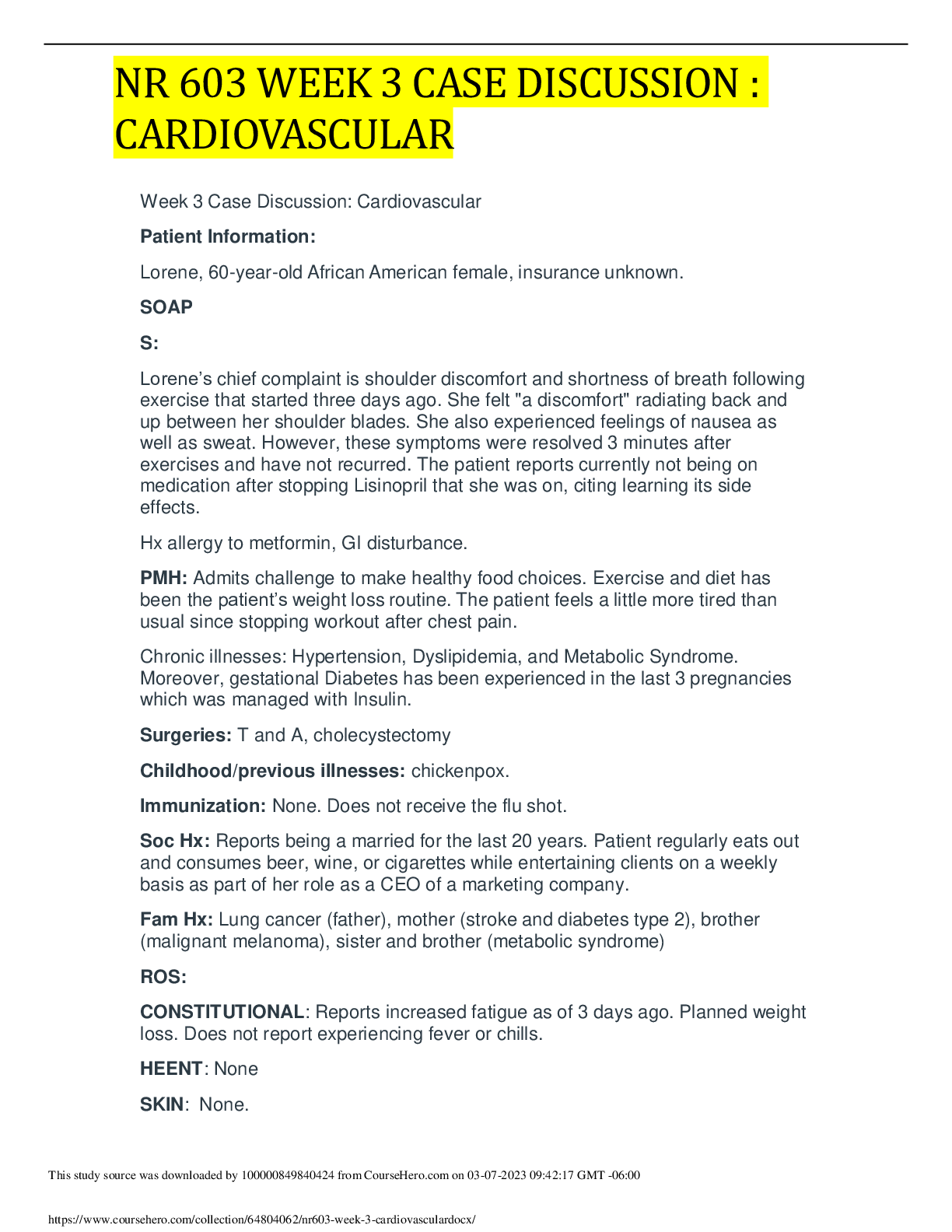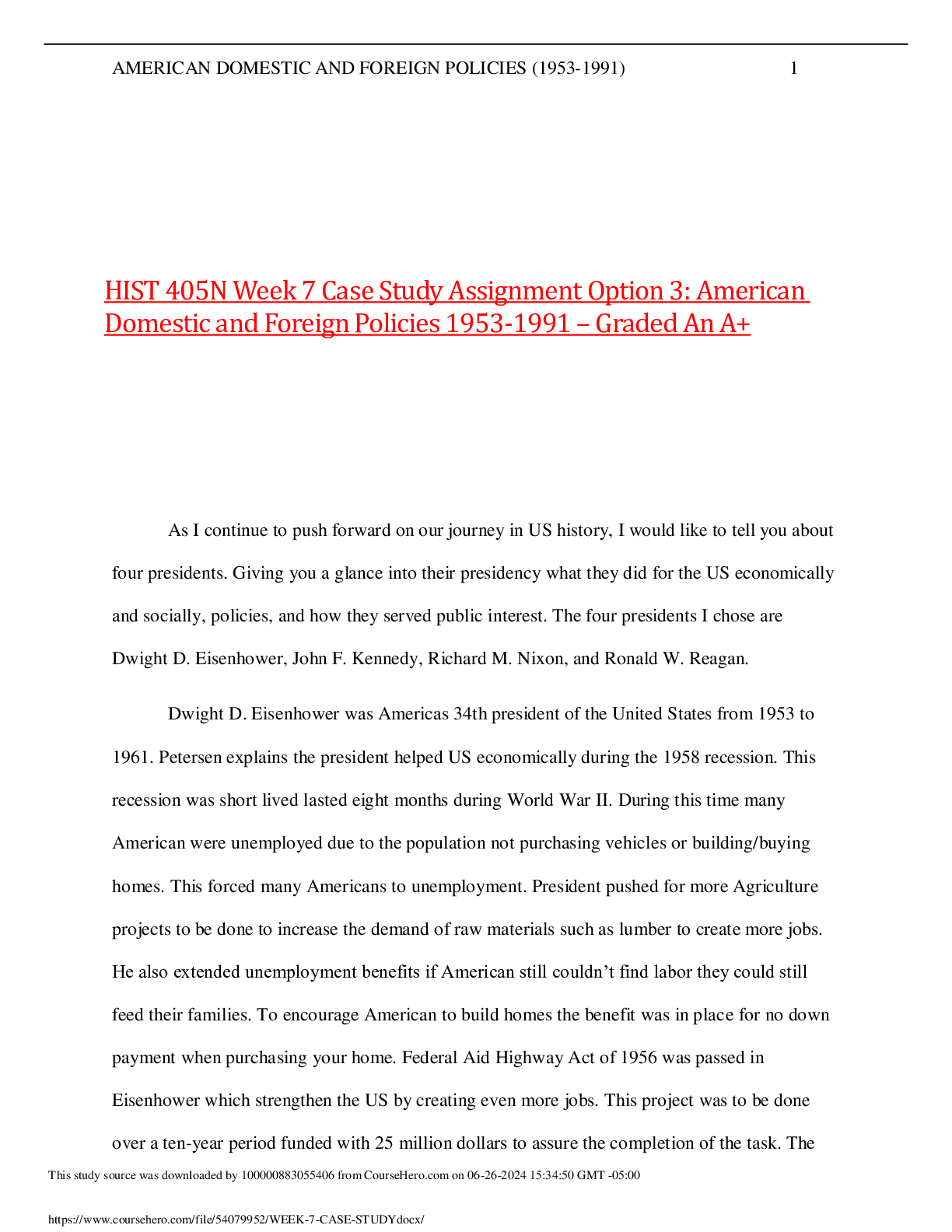*NURSING > CASE STUDY > NR 603 Week 2: Case Discussion Pulmonary – Part 1- RATED A+ (All)
NR 603 Week 2: Case Discussion Pulmonary – Part 1- RATED A+
Document Content and Description Below
1. What is your primary diagnosis for Michelle given the pattern of occurrence of symptoms, exam results, and recent history? Include the rationale and a reference for your diagnoses. Diagnosis: Mi... ld to moderate persistent asthma with episode of shortness of breath (SOB) related to occupational problems/ work circumstances. ICD code: J45.30 and Z56.9 Asthma Asthma is a chronic airway inflammation characterize by respiratory symptoms such as SOB, coughing, wheezing and tightness of the chest, along with a variable of expiratory airflow limitation. A diagnosis of asthma be confirmed by a history of various respiratory symptoms and pulmonary function test (PFT). A diagnosis of asthma can be diagnosed by the patient past respiratory symptoms and a FEV1 greater than 12% difference between a pre-and-post PFT (GINA, 2020). Rationale: The patient has a history of seasonal allergies, recent episodes of SOB and a few months ago visited an urgent care for her SOB. The patient’s physical exam presents slight wheezing on inspiration and forced expiration with wheezing that does not clear with forceful coughing. The patient pre-PFT resulted in a FEV1/FVC of 60% and the post- PFT resulted in a FEV1/FVC of 75%, which is greater than 12% improvement indicating a diagnosis of asthma as per the GOLD guidelines (GINA, 2020). Occupational asthma is an exposure of substance(s) that causes an exacerbation or contribute to worsening of preexisting condition in the workplace. Classic symptoms of occupational asthma may include coughing, difficulty breathing, wheezing, and tightening of the chest (Bepko and Mansalis, 2016). Rationale: HPI: The patient reports SOB mostly occurs at work and resolves before arriving home. Upon returning to work, the patient reports her SOB returns. The episodes of SOB do not occur on the weekends. Based on her HPI the patient symptoms are associated with occupational asthma. 2. What is your first-line treatment plan for Michelle including medications, labs, education, referrals, and follow-up? Identify the drug class of each medication you prescribe and exactly what symptom it is targeted to address. Medications Based on the GINA guidelines, Michelle should be started on a following medication: 1. Low dose corticosteroid and long-acting-beta-agonist (ICS-LABA): (GINA, 2020) • Advair (Fluticasone/salmeterol): 2 puff PO Q12 hours. Disp #:1 Advair is a combination drug of fluticasone and salmeterol used to treat respiratory symptoms such as SOB, wheezing, tightness of the chest, difficulty breathing due to asthma. Fluticasone is a corticosteroid that helps by reducing irritation and swelling of the airway. Salmeterol is a long-acting-beta-agonist (LABA) that helps relax and open an air passage to the lungs. Short acting-beta-antagonist (SABA): A SABA as-needed for severe uncontrolled asthma exacerbations (U.S. NLOM, 2020). 2. Short-acting-beta-agonist (SABA) (GINA, 2020) • Albuterol sulfate: PROAIR HFA 108 mcg/puff Sig: 2 puff PO Q4-6 hours as needed for SOB. Disp #: 1 PROAIR FA is an aerosol inhalator that treat and prevents bronchospasm and exercise- induced bronchospasm (FDA, 2019). Plan of Treatment: 1. Action plan: An action plan will be created, and a written copy will be provided. The patient will be educated on steps to follow if asthma symptoms worsen and when to seek emergency care (GINA, 2020). 2. Allergy skin prick test: Since the patient has environment allergic asthma exacerbation triggers an allergy skin prick (epicutaneous) test is recommended to help identify possible environmental asthma exacerbation triggers (If the clinic does not offer the allergy skin prick test, a referral will be needed (Quirt, J., Hildebrand, K.J., Mazza, J. et al., 2018). Labs: No labs are needed at this time. Education: • Michelle will be educated on the proper use of antibiotic. (Details listed below.) • Medication education will be provided on how to properly use an aerosol inhalator, overuse, possible side effects and drug interactions (FDA, 2019). • Michelle will be educated to avoid environmental triggers and use her action plan to help manage her asthma exacerbations (Quirt, J., Hildebrand, K.J., Mazza, J. et al., 2018). Referrals: Michelle does not need a referral currently. A referral will be considerate if her symptoms do not improve, symptoms worsen, frequency of exacerbation increases. Follow up: • Michelle needs to follow up in 2 weeks to evaluate the effectiveness and possible side effects of her pharmacological therapy. • Then a 3-months follow up to assess and monitor asthma control. • Then every 3 months to assess and determine possible adjustment (step-down) to therapy as needed (NIH, 2021). 3. Address Michelle's request for an antibiotic Antibiotic is not recommended for acute asthma exacerbation. Michelle needs to be educated on the use for proper antibiotic (Stempel. D.A., 2019). Michelle, most asthma triggered exacerbations are associated with viral infection and the use of antibiotics may worsen your symptoms. Antibiotics should only be used in the presence of a lung infection. Signs and symptoms of a lung infection may include fever, purulent sputum and/or pneumonia. Based on your assessment today, the need for antibiotics is not recommended. For an acute asthma exacerbation, a short-acting beta- agonist and a corticosteroid are recommended (Stempel. D.A., 2019). References Allergy and Asthma Medication Guide (2020). American Academy of Allergy Asthma and Immunology. Retrieved from https://www.aaaai.org/conditions-and- treatments/drug-guide/saba Asthma Care Diagnosing and Managing Asthma (2021). National Institutes of Health. Retrieved from: https://www.nhlbi.nih.gov/files/docs/guidelines/asthma_qrg.pdf Bepko, J., & Mansalis, K. (2016). Common occupational disorders: Asthma, COPD, dermatitis, and musculoskeletal disease. American Family Physician. Retrieved from: https://eds-a-ebscohost- com.chamberlainuniversity.idm.oclc.org/eds/pdfviewer/pdfviewer? vid=1&sid=fc8846a5-5871-4ef2-855e-836a07f2aaf2%40sdc-v-sessmgr02 Global Initiative for Asthma (GINA). (2020). Global Strategy for Asthma Management and Prevention. Retrieved from: https://ginasthma.org/wp- content/uploads/2020/06/GINA-2020-report_20_06_04-1-wms.pdf Quirt, J., Hildebrand, K.J., Mazza, J. et al. (2018). Asthma. Allergy Asthma and Clinical Immunology. Retrieved from: https://doi.org/10.1186/s13223-018-0279-0 Stempel, D.A. (2019). Determining the appropriate use of antibiotic for treatment of acute asthma. The Journal of Allergy and Clinical Immunology: In practice. Retrieved from: https://www.jaci-inpractice.org/article/S2213-2198(18)30700-1/fulltext. U.S. Food and Drug Administration. (2019). PROAIR HFA. Albuterol sulfate inhalation aerosol. Retrieved from https://www.accessdata.fda.gov/drugsatfda_docs/label/2019/021457s036lbl.pdf U.S. National Library of Medicine. (2020). Fluticasone and Salmeterol oral inhalation. MedlinePlus. Retrieved from: https://medlineplus.gov/druginfo/meds/a699063.html [Show More]
Last updated: 2 years ago
Preview 1 out of 5 pages

Buy this document to get the full access instantly
Instant Download Access after purchase
Buy NowInstant download
We Accept:

Reviews( 0 )
$15.00
Can't find what you want? Try our AI powered Search
Document information
Connected school, study & course
About the document
Uploaded On
Mar 07, 2023
Number of pages
5
Written in
Additional information
This document has been written for:
Uploaded
Mar 07, 2023
Downloads
0
Views
107


